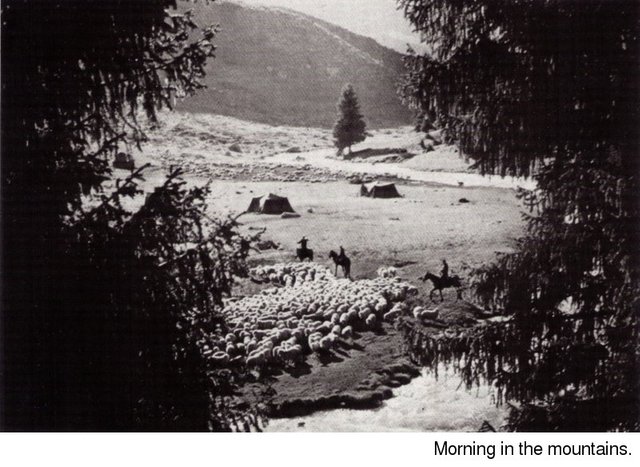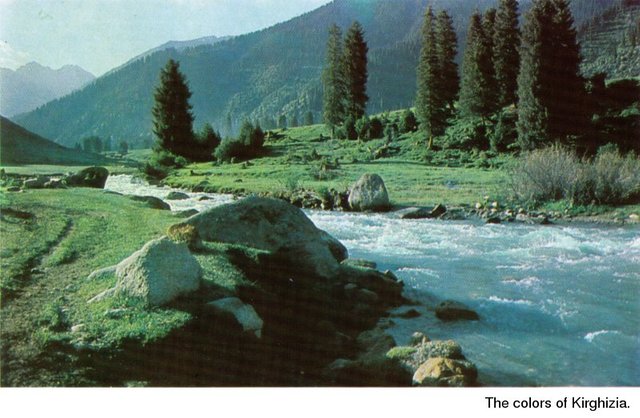Mountain Pastures (featuring Vasily Peskov as author)
This is a photograph of a valley in Kirghizia, of one of its countless streams and countless flocks of sheep. This scene is as typical of Kirghizia as a birch copse or a field of rye are of Central Russia.

There are plains in Kirghizia, too, and vineyards, and fields of beets, wheat, opium poppies and cotton, with villages that can be spotted from a distance by the dark tops of the surrounding poplars. However, you can see the mountains from any road in the plains, from any spot in the Republic. They are to the left and right, and sometimes all around you. They are white, smokey-blue or barely visible beyond the mist and clouds. The mountains are everywhere. Although they seem so close, one sometimes has to travel a day to reach the foothills. As you climb higher the various altitudinal belts pass in succession. At the bottom are the dusty rocks and nettles of the desert. Higher up are the green forests. Then comes the alpine zone with its abundance of bright flowers and grasses. Next are the naked rocks and, finally, the snow, where often there is not even a pass in summertime. The mountains are everywhere. Though the plains are fertile, Kirghizia's wealth lies in its mountains.
You pass through a valley and see sheep. You climb higher and see more sheep, and when you reach the rocks where there seems to be no grass at all, you discover that the sheep are grazing here, too. In these cool heights life meanders along as the wooly crop ripens.
As everywhere nowadays, there are a great number of vehicles on the roads. Still, as often as not, you will encounter a rider. There are times in the year when the flocks take over the roads. The trucks slow down, or else do nothing but transport sheep during the season. Sometimes it is more profitable to fly the flocks into the mountains by plane, since sheep loose weight quickly when they are on the road. Kirghizia's chief treasure multiplies here in summer on the green slopes by the cold streams.
Look at the photograph closely. It is early morning. The sun has just reached the valley. The shepherds have had their bowl of koumiss, saddled their horses and are driving the flock to the pasture higher up in the mountains. All day long the sheep will graze near the peaks, returning to the river at nightfall. A shepherd spends the summer in the mountains. Often his wife and children come to live with him in his tent. That is why they try to choose a spot that is both convenient and beautiful for their camp. Since the shepherds never retire early, campfires burn outside the tents far into the night. The day's affairs are discussed unhurriedly as the iamb stew bubbles and someone strums a komuz in the darkness. These days a transistor radio often replaces the ancient komuz and a portable gas burner is often the new cook-fire.

The people of modern Kirghizia are agronomists, doctors, truck drivers, architects, pilots and metal workers, but the ancient profession of the shepherd is still the chief occupation. In summer eleven million sheep graze in the mountains. These are future fur coats and collars, felt boots, attractive sweaters, soldier's uniforms, mittens and fine quality suits. There was a time when it was feared that man-made fibers would one day make wool obsolete. Strangely, however, although synthetic fabrics have flooded the market, the demand for wool has not diminished. On the contrary, it keeps growing, for natural fibers, fur and leather are still more attractive and more durable than their artificial counterparts. Then again, sheep grazing in the mountains mean lamb and mutton, and cheese, besides fur coats and sweaters. That is why there will never be too many shepherds. This occupation will exist for as long as there are mountains. Thus, the mountain people will continue forever to take in their wooly harvest.